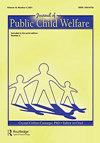行为健康和法律系统参与的过渡年龄青年寄养:在加州青年的纵向分析
IF 1.2
4区 社会学
Q3 SOCIAL WORK
引用次数: 0
摘要
摘要研究表明,寄养家庭的青少年在向成年过渡过程中存在高水平的行为健康问题,这些问题可能导致生活障碍,包括法律系统介入(LSI)。然而,很少有纵向研究从行为健康的角度考察了青少年在过渡到成年期的LSI。为了了解与成人LSI相关的青少年行为健康状况,我们使用了寄养青少年的纵向调查数据(n = 540)来比较后来报告LSI的青少年和没有报告LSI的青少年(19-21岁)之间不同行为健康障碍的患病率(17岁)。我们还研究了青少年行为健康障碍和成人LSI之间的联系,并考虑了其他协变量。我们发现,与那些在成年早期报告较晚LSI的青少年相比,在17岁时出现四种行为健康障碍的比例明显更高:酒精使用、药物使用、行为障碍和对立违抗障碍。回归结果显示,在考虑了其他协变量后,17岁时的药物使用障碍是后期LSI的一个特别强的预测因子。许多人经历过各种各样的LSI风险因素,包括行为健康需求。我们讨论了在儿童福利背景下对实践、政策和研究的影响。关键词:作者要感谢加州社会服务部的合作伙伴和加州青年研究项目的资助者——康拉德·n·希尔顿基金会、瑞萨基金会、沃尔特·s·约翰逊基金会、泽勒巴赫家庭基金会、威廉·t·格兰特基金会、以及加州健康基金会,感谢他们对本研究中使用的行政数据的支持,以及对青少年政策评估和项目开发的承诺。披露声明作者未报告潜在的利益冲突。本文所报告的调查结果是在加州社会服务部的许可下进行的。此处表达的观点和结论仅代表作者的观点和结论,不应被视为代表合作机构或加州政府任何机构的政策。朴槿惠是密歇根州立大学社会工作学院的助理教授。她的研究兴趣包括儿童福利服务和政策、青少年司法服务和政策、边缘化青少年的教育经历以及寄养青少年向成年的过渡。Park的工作建立在她在公立学校、青少年拘留中心、国家儿童和家庭服务部门以及研究机构的实地实践基础上。Michelle Munson是纽约大学西尔弗社会工作学院的教授。她的专业兴趣是心理健康服务研究、干预开发和测试,她的工作主要集中在青少年和年轻人身上。Munson博士的研究旨在了解社会的结构条件和社会关系是如何通过语言和非语言交流来塑造年轻人寻求(或不寻求)专业心理健康服务的决定的。她的研究和奖学金也致力于为患有严重精神健康状况的青少年和年轻人开发、完善、调整和测试参与和治疗干预措施。Mark E. Courtney是芝加哥大学皇冠家庭社会工作、政策和实践学院的Samuel Deutsch名誉教授,也是加州大学伯克利分校加州儿童福利指标项目的杰出研究员,在那里他共同指导过渡年龄青年研究和评估中心(TAY-Hub)。他特别感兴趣的领域是儿童福利政策和服务,儿童福利服务与其他服务贫困家庭的机构之间的联系,边缘人群向成年期的过渡,以及社会工作的专业化。Kierra BlairKierra Crisswell是一名研究助理,获得芝加哥大学皇冠家庭社会工作、政策和实践学院的城市生活垃圾学位。本文章由计算机程序翻译,如有差异,请以英文原文为准。
Behavioral health and legal system involvement among transition-age youth in foster care: a longitudinal analysis of youth in California
ABSTRACTResearch shows that young people in foster care experience high levels of behavioral health problems that may lead to life obstacles, including legal system involvement (LSI) during the transition to adulthood. However, few longitudinal studies have examined LSI among foster youth from a behavioral health perspective during the transition to adulthood. To understand adolescent behavioral health conditions associated with adult LSI, we used longitudinal survey data of young people in foster care (n = 540) to compare the prevalence of different behavioral health disorders (age 17) between youth who later reported LSI and those who did not (ages 19–21). We also examined associations between adolescent behavioral health disorders and adult LSI, accounting for other covariates. We find that compared to those who did not, youth who reported later LSI in early adulthood had significantly higher rates of four behavioral health disorders at age 17: alcohol use, drug use, conduct disorder, and oppositional defiant disorder. Regression results showed drug use disorder at age 17 to be a particularly strong predictor of later LSI after accounting for other covariates. Many individuals experience various risk factors for LSI, including behavioral health needs. We discuss implications for practice, policy, and research in the child welfare context.KEYWORDS: Behavioral healthlegal system involvementtransition to adulthoodfoster carechild welfare AcknowledgmentsThe authors would like to thank partners at the California Department of Social Services and CalYOUTH Study project funders—the Conrad N. Hilton Foundation, the Reissa Foundation, the Walter S. Johnson Foundation, the Zellerbach Family Foundation, the William T. Grant Foundation, and the California Wellness Foundation—for the support for administrative data used in this study and commitment to policy evaluation and program development for youth.Disclosure statementNo potential conflict of interest was reported by the authors.Additional informationFundingThe findings reported herein were performed with the permission of the California Department of Social Services. The opinions and conclusions expressed herein are solely those of the author and should not be considered as representing the policy of the collaborating agency or any agency of the California government.Notes on contributorsKeunhye ParkKeunhye Park is an Assistant Professor at Michigan State University’s School of Social Work. Park’s research interests include child welfare services and policy, juvenile justice services and policy, educational experiences of marginalized youth, and the transition to adulthood among foster youth. Park’s work builds upon her field practice in public schools, juvenile detention centers, state departments of children and family services, and research institutes.Michelle R. MunsonMichelle Munson is a Professor at NYU Silver School of Social Work. She has professional interests in mental health services research and intervention development and testing, and her work centers on adolescents and young adults. Dr. Munson’s research seeks to understand how society’s structural conditions and social relationships, through both verbal and non-verbal communication, shape young adults’ decisions to seek (or not seek) professional mental health services. Her research and scholarship also seeks to develop, refine, adapt, and test engagement and treatment interventions for adolescents and young adults with serious mental health conditions.Mark E. CourtneyMark E. Courtney is the Samuel Deutsch Professor emeritus in the Crown Family School of Social Work, Policy, and Practice at the University of Chicago and Distinguished Researcher at the California Child Welfare Indicators Project at the University of California, Berkeley, where he co-directs The Transition Age Youth Research and Evaluation Hub (TAY-Hub). His fields of special interest are child welfare policy and services, the connection between child welfare services and other institutions serving families living in poverty, the transition to adulthood for marginalized populations, and the professionalization of social work.Kierra BlairKierra Crisswell is a research assistant and received an MSW degree from the Crown Family School of Social Work, Policy, and Practice at the University of Chicago.
求助全文
通过发布文献求助,成功后即可免费获取论文全文。
去求助
来源期刊

Journal of Public Child Welfare
SOCIAL WORK-
CiteScore
3.10
自引率
12.50%
发文量
38
期刊介绍:
Decisions made in the practice of child welfare have lifelong effects on children and their entire families which in turn affects every facet of society. To effectively practice in this vital field, social workers, psychologists, counselors, juvenile court judges, attorneys, and other child welfare professionals need to stay informed about the latest findings and important issues in public child welfare. To answer this crucial need, the Journal of Public Child Welfare provides a broad forum for theory-based and applied research in child welfare. Rather than limit itself to primarily private agencies, this essential journal provides the quality research and comprehensive information that child welfare professionals and public agencies need most.
 求助内容:
求助内容: 应助结果提醒方式:
应助结果提醒方式:


